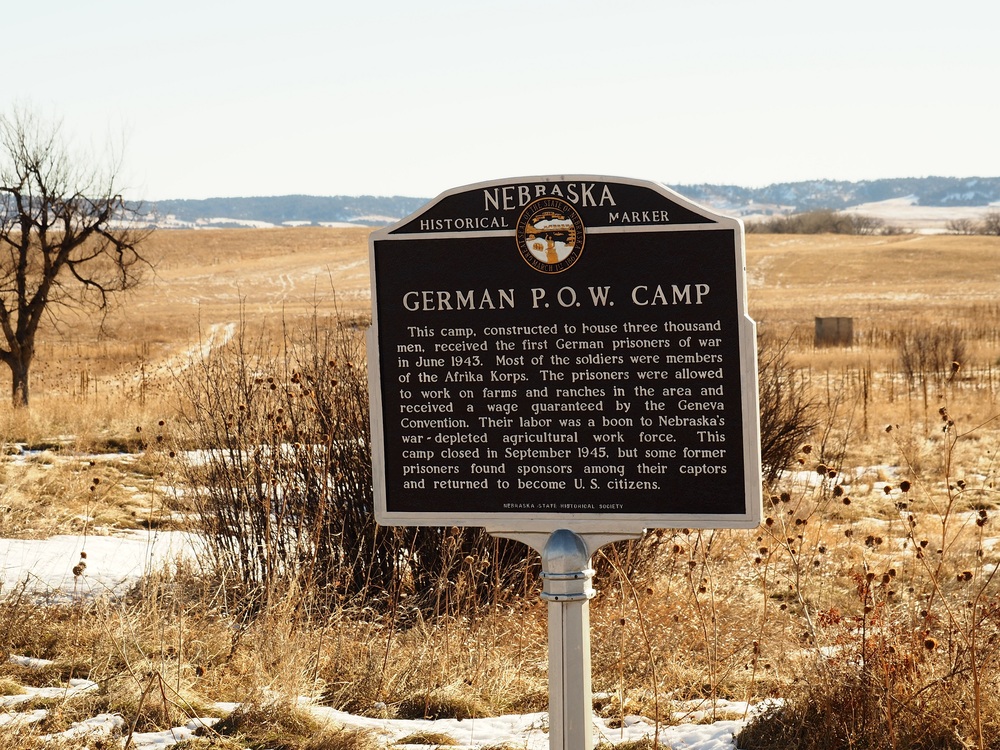Our Historical Markers across Nebraska highlight fascinating moments and places in our state’s past. Today we’re focusing on a small marker that tells a big story: the German P.O.W. camps out at Fort Robinson during World War II.
Marker Text
This camp, constructed to house three thousand men, received the first German prisoners of war in June 1943. Most of the soldiers were members of the Afrika Korps. The prisoners were allowed to work on farms and ranches in the area and received a wage guaranteed by the Geneva Convention. Their labor was boon to Nebraska’s war-depleted agricultural work force. This camp closed in September, 1945, but some former prisoners found sponsors among their captors and returned to become U.S. citizens.
Marker Location
Rural Crawford, Dawes County; View this marker’s location
Additional Information
Background
During World War II, Fort Robinson was the site of an internment camp for German prisoners of war. The Fort Robinson camp was one of three prisoner of war camps in the State of Nebraska. Approximately 425,000 Axis soldiers came to America as prisoners of war during the Second World War (1939-1945). The prisoners were held at 126 camps across the country where they were used as workers, helping to fill the employment void left by American soldiers fighting abroad.
The War Comes to Nebraska
World War II was fought on battlefields in Europe, Africa and the Pacific, where thousands of soldiers and civilians fought and died. Nebraska, however, was shielded from the scourge of war by the large distance between it and the fighting. The war became less of an abstraction and more of a reality for Nebraskans in November of 1942, when the military decided to build a prisoner of war camp at Fort Robinson.
The Camp
The first compound created for the camp had a capacity of about a thousand men. Later, two other compounds were built to raise capacity to 3000. Several hundred guards, interpreters and other personnel also lived at the camp. On November 19, 1943, the first round of prisoners arrived at the camp. 600 in number, these soldiers had been in Field Marshall Rommel’s Afrika Korps. The camp population remained at about this level until the invasion of Normandy in June of 1944. By December of that year, the camp was at full capacity. All of the prisoners were from the German army until 1945, when the camp was switched to a naval camp. Some prisoners at the camp worked at farms and ranches while others helped with the horses and mules in camp. (Fort Robinson was the world’s largest remount depot. A remount depot took care of the horses and mules needed by the military.) They received a salary for their work, as per the Geneva Convention.
De-Nazifying
While most of the prisoners were conscripts, about 30 percent were Nazis or Nazi sympathizers. This created problems at the camp. While the Nazis made sure the camp was well-run to please their American captors, they were unsurprisingly discriminatory, mistreating Austrian-born soldiers and perceived traitors. Otto Ludwig was abused by his comrades after he said, “If we win the war, I will never return to Germany, if we loose [sic] it I will ‘deliver the Nazis to the knife.” He was later moved to another camp for his protection. These incidents affirmed the need for “re-education” programs to “de-Nazify” prisoners. The Fort Robinson POW camp was part of the top-secret Intellectual Diversion Program, whose goal was to expose the prisoners to “the facts of American history, the workings of democracy and the contributions made to America by peoples of all national origins.” Since the Geneva Convention banned showing propaganda to prisoners, the program presented entertainment materials that subtly promoted American values. The theater at the camp screened, among other things, movies starring Marlene Dietrich, a famous German star who had moved to America, and intellectual films about American life. Prisoners were not forced to watch these films, so attendance was not usually high. The only films that required attendance were films showing Nazi atrocities, which were shown after Germany surrendered. The effects of the program are unknown. Each prisoner in an American POW camp saw about 30 films while in camp.
The End of the War
Germany surrendered in May of 1945. The last prisoners left the camp in May of 1946. Some of them returned to America and became American citizens.




